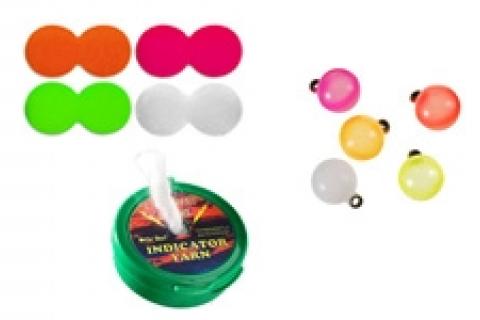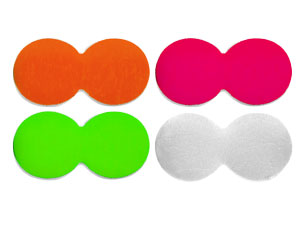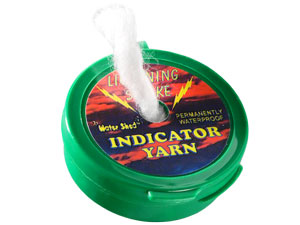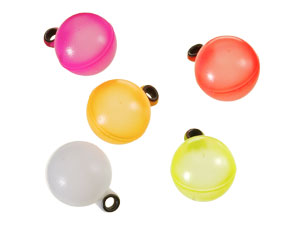
 |
| Pinch-on foam indicators are popular with fly fishermen because they're small and easy to use. |
For as long as I can remember, my friends and I have always fly fished the early spring runs of steelhead trout when the river conditions are normally high, fast and stained. Ideally streamers such as, eggs or nymph patterns are to be fished dead-drifted or bounced across the bottom.
If and when a fish does strike the fly, anglers usually cannot feel the take and end up losing the chance to hook the fish. To help fly anglers, many varieties of strike indicators have been created specifically for this reason and are available on the market today. These indicators come in many different styles that range from colorful putties, soft yarns, to foam press and stick discs. Each different type of indicator is not able to successfully fish all the varying types of water you will encounter along a stream, so knowing what works best and when will increase your odds of hooking and landing a lake run beauty.
The diversity of strike indicators available today is overwhelming to even the most experienced fly angler. For the most part five main types of indicators exist, and all of them work pretty well in the water conditions they were created for. The one you choose to use should be based on personal preference and the type of water you plan on fishing most.
Fly Anglers Like Foam Indicators
Foam indicators over the last few years probably have been the most popular among fly anglers because of their durability, ease of sight, and simplicity of adjustment. Due to the buoyancy of the materials used in construction of cork or foam indicators, these indicators are the best for deep, fast water because they seem almost impossible to drown. These types of indicators slide onto the leader meaning you have to have the indicator in place before you attach your flies. Some of these indicators use a toothpick or small wedge of plastic jammed into the opening to hold things in place.
One disadvantage of this type of system is that the toothpick can cause tangles by catching the line when casting. Some of the newer models of foam indicators now incorporate different methods for attaching the indicators to the leader and for holding them in place, meaning no more cutting of the leader to attach indicators and less chance of fouling while casting. Another disadvantage of these foam indicators is that they can be hard to cast accurately and quietly due to wind resistance and their weight.
Pinch-on foam indicators have become popular in the last few years because of their small size and ease of use. These indicators are great for small stream fishing where long powerful casts are not being used to present flies — these types of casts usually peel these indicators from your leader. These indicators do not ride as high in the water column as other foam or cork indicators so using them in smaller waters with less current is ideal. Additionally the small size rarely spooks fish and can be presented very quietly.
One of the major disadvantages of this type of indicator system is that over time fish can become familiar with the indicators and spook as the indicator drifts overhead. Whether it be the bright color, or the shadow cast to fish by the high-floating indicator when fish start acting weary around your indicators changing things up and sizing down is the only way to go.
Fly Fishing With Yarn Indicators
 |
| Yarn indicators like this Lightning Strike Indicator are waterproofed so that it can float on the water surface for hours. |
Yarn indicators are simple tools for the avid angler, being composed of synthetic yarns or wool yarns. These are treated with a waterproofing agent that will allow the indicator to ride on the waters surface for hours on end. For most yarn indicators attachment comes by looping the leader material around the float in a slip knot type fashion. This type of attachment is great for quick readjustments needed in a days fishing. With the creation of Glo-Bug yarn or synthetic yarn — having a very visible indicator system is possible.
The big advantage of yarn indicators is that due to the special soft nature of the fibers in yarns, detecting very light strikes fish is easy. The yarn's softness serves another purpose in making indicators less invasive and disturbing to weary trout. Use bright colors when fishing bigger waters with less finicky fish and subtle whites or blacks on small clear waters with spooky fish.
One downfall of this type of indicator system is that yarn is more wind-resistant than most foam indicators this makes it hard to present small flies accurately. Probably the biggest disadvantage of this type of indicator is that with larger flies or very fast currents the indicators can become pulled below the water's surface making it hard to follow. In these instances switching to a different type of indicator system will make life easier.
Putty Indicators for Fly Fishing
Putty indicators are relatively new to the fly fishing community, and come in a wide variety of fluorescent colors that will catch your eye from across the room. This putty can be molded by your fingers to any point on the leader section and in any size necessary.
The advantages to this putty are that in does come in very bright colors making it easy to see, even at night with glow in the dark putty. Also this product can be removed from the line and reused at a later date. Since indicator putty can be applied in any size you can make tiny indictors that are necessary for fishing spooky fish. The disadvantages to using this putty is that compared to all other brands of indicators it is quite expensive. Also this putty does not hold to the leader very well so if you plan on long casts or rough conditions the likelihood of the putty holding to the leader is small.
Fly-line Indicators
Fly-line indicators are probably the oldest type of indicator on the market, having been available as early as the '70s. Scientific Anglers was the first company to make these types of indicators and they became especially useful for anglers who loved to nymph with small flies in shallow waters. These fly-line indicators are still available, but maybe a little hard to find. Attachment of these indicators is done by glue or by tying a double overhand knot in the leader butt. By sliding in these sections of line you can make an indicator system that works in a wide range of water depths.
By tying one fly line indicator at the butt section and two more along the leader section in even intervals this set up can help fly anglers track small nymphs, emergers easily. One of the major advantages of these indicators is that fish for the most part do not take notice to these types of indicators. Also these indicators do not effect presentation or casting of flies. The disadvantages of this type of indicator system come from the fact that at times in fast water or low light conditions it can be very hard to follow and you may miss strikes from fish. Since this indicator system is not always above surface anglers need to adjust and get used to watching an indicator beneath the surface.
|
Tip: Instead of purchasing a store-bought indicator, some anglers choose to simply alter their fishing systems to allow for detection of strikes from fish. The first of these techniques is to use the end of the fly line as an indicator system. If you plan on using this type of system, a tip is to mark the end of the fly line with a black permanent marker creating contrasting colors on the fly line to help spot any movements of the fly line against the water. The second technique would be to use the leader butt as an indicator. In this technique the angler colors the butt section of the line so that he or she can detect takes from fish. Both of these techniques are excellent for targeting highly pressured, weary fish seeing as no additional tackle is added to the leader section which might spook fish. Anglers should be warned that using these fly line alterations as indicator is not as sensitive as the other methods and sometimes distinguishing strikes from the fly bouncing the bottom can be very difficult. |
Dry-Fly Indicators for Fly Fishing
With this type of indicator a large a buoyant dry fly serves as the indicator. This is a very easy indicator system to use while fishing because all the necessities are already in your vest. To fish this system tie the dry fly as you normally would to the end of the leader and then tie a short section of tippet material to the hook bend on the dry fly. On to this tippet tie or attach whatever small nymph, emerger, or dry fly you think will catch fish.
Variation in the length of tippet used from the dry fly to the dopper will vary depending on the depth and speed of the water you will be fishing. Moreover you're not constrained in the type of dry fly you have to use with this set up, it can range from a size 18 BWO to a size 4 Foam Hopper. The only consideration you need to make is that the indicator dry fly must be able to support the trailing nymph. Large dry flies like stimulator patterns are able to support heavily-weighted nymphs.
The advantages of this type of indicator are clear; instead of fishing just one column of the water you are fishing two. There are many times when fish will hit the dry fly instead of the nymph simply because it is a bigger sized meal. This dry and dopper technique is also good for fishing spooky fish in clear water. The major disadvantage of this type of indicator system is that it is geared toward shallow streams (depths up to 5 feet) and not deep water presentations.
Another windfall of this type of indicator system is that casting two flies in tandem can lead to many tangles and knots forming in the leader section.
Plastic Bobber Indicators
 |
| Plastic bobbers are indicators on the market and are perfect for fishing fast, choppy waters. |
Bobber style indicators are soft and squishy, but very tough. Some of the key qualities to these indicators are that they are very visible, sensitive, float higher than cork or yarn and are easier to cast. They're special design came from guides who use small balloons as strike indicators for their buoyancy and sensitivity. The large size is perfect for spring steelhead fishing in high water conditions.
The reason behind using indicators is simple, to accurately detect strikes from fish when presenting flies with an on or near bottom presentation. Although it sounds easy, being able for find the right indicator to best fit you specific needs is not always straightforward due to the sheer number and assortment of products on the market.
After satisfying the two basic necessities of indicators, ease of sight and floatability understanding the best possible uses for each of the varying styles and keeping these needs in mind when deciding what indicator system best fits your needs will help anglers effectively fish every pool, run or riffle they come across.
Fishing Strike Indicator Breakdown
| Type | Advantages | Disadvantages | Water |
| Foam | Durable; easy to use; simple to adjust | Toothpick can cause tangles by catching the line when casting; can be hard to cast accurately and quietly due to wind resistance and their weight. | Deep, fast waters |
| Pinch-on Foam | Small size rarely spooks fish and can be presented quietly; easy to use | Not suited for long powerful casts; do not ride as high in the water column as foam or cork; fish can become familiar with indicator and be spooked when drifting overhead. | Small stream; less current |
| Yarn | Waterpoof so it floats on water for hours; quick readjustments; very visible; detects light strikes; less invasive and disturbing | More wind-resistant than most foam indicators, making it hard to present small flies accurately; with larger flies or very fast currents, indicators can become pulled below the water's surface making it hard to follow. | Small or big waters; less current |
| Putty | Molded by our fingers to any point on the leader section and in any size; comes in very bright colors making it easy to see; good for easily spooked fish | Expensive; does not hold to the leader well so long casts or rough conditions are not recommended | Less current |
| Fly Line | Quiet presentation for spooked fish; does not effect presentation or casting | Can be hard to find in stores; indicator doesn't always stay above water so in fast water or low light conditions, can be hard to follow and you may miss strikes. | Any depth; calm water |
| Dry-Fly | Easy to use; not constrained in the type of dry fly used; fish two columns of water; good for easily spooked fish | Some times fish will hit dry fly instead of nymph because it's bigger; casting two flies in tandem can lead to many tangles and knots forming in the leader section | Shallow streams (less than 5 feet deep) |
| Plastic Bobber | Durable; easy to see; sensitive; float higher than cork or yarn; easier to cast | Shadow can spook fish in clear, shallow water | Fast, choppy water; high water conditions |
- 14830 views

